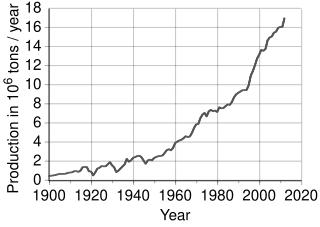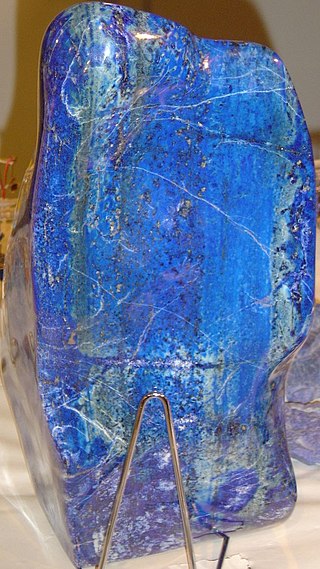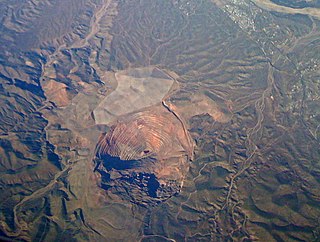
Ore is natural rock or sediment that contains one or more valuable minerals concentrated above background levels, typically containing metals, that can be mined, treated and sold at a profit. The grade of ore refers to the concentration of the desired material it contains. The value of the metals or minerals a rock contains must be weighed against the cost of extraction to determine whether it is of sufficiently high grade to be worth mining, and is therefore considered an ore. A complex ore is one containing more than one valuable mineral.

Chuquicamata is the largest open pit copper mine in terms of excavated volume in the world. It is located in the north of Chile, just outside Calama, at 2,850 m (9,350 ft) above sea level. It is 215 km (134 mi) northeast of Antofagasta and 1,240 km (770 mi) north of the capital, Santiago. Flotation and smelting facilities were installed in 1952, and expansion of the refining facilities in 1968 made 500,000 tons annual copper production possible in the late 1970s. Previously part of Anaconda Copper, the mine is now owned and operated by Codelco, a Chilean state enterprise, since the Chilean nationalization of copper in the late 1960s and early 1970s. Its depth of 850 metres (2,790 ft) makes it the second deepest open-pit mine in the world, after Bingham Canyon Mine in Utah, United States.

Codelco is a Chilean state-owned copper mining company. It was formed in 1976 from foreign-owned copper companies that were nationalised in 1971.

Porphyry copper deposits are copper ore bodies that are formed from hydrothermal fluids that originate from a voluminous magma chamber several kilometers below the deposit itself. Predating or associated with those fluids are vertical dikes of porphyritic intrusive rocks from which this deposit type derives its name. In later stages, circulating meteoric fluids may interact with the magmatic fluids. Successive envelopes of hydrothermal alteration typically enclose a core of disseminated ore minerals in often stockwork-forming hairline fractures and veins. Because of their large volume, porphyry orebodies can be economic from copper concentrations as low as 0.15% copper and can have economic amounts of by-products such as molybdenum, silver, and gold. In some mines, those metals are the main product.

Silver mining is the extraction of silver from minerals, starting with mining. Because silver is often found in intimate combination with other metals, its extraction requires elaborate technologies. In 2008, ca. 25,900 metric tons were consumed worldwide, most of which came from mining.

A polymetallic replacement deposit, also known as carbonate replacement deposit or high-temperature carbonate-hosted Ag-Pb-Zn deposit, is an orebody of metallic minerals formed by the replacement of sedimentary, usually carbonate rock, by metal-bearing solutions in the vicinity of igneous intrusions. When the ore forms a blanketlike body along the bedding plane of the rock, it is commonly called a manto ore deposit. Other ore geometries are chimneys and veins. Polymetallic replacements/mantos are often stratiform wall-rock replacement orebodies distal to porphyry copper deposits, or porphyry molybdenum deposits. The term manto is from the Spanish word for mantle, or cloak, although the geologic manto is more like a mantle roll than a sheetlike structure.

Mining in Iran is still under development, yet the country is one of the most important mineral producers in the world, ranked among 15 major mineral-rich countries, holding some 68 types of minerals, 37 billion tonnes of proven reserves and more than 57 billion tonnes of potential reserves worth $770 billion in 2014. Mineral production contributes only 0.6 percent to the country's GDP. Add other mining-related industries and this figure increases to just four percent (2005). Many factors have contributed to this, namely lack of suitable infrastructure, legal barriers, exploration difficulties, and government control.

Creighton Mine is an underground nickel, copper, and platinum-group elements (PGE) mine. It is presently owned and operated by Vale Limited in the city of Greater Sudbury, Ontario, Canada. Open pit mining began in 1901, and underground mining began in 1906. The mine is situated in the Sudbury Igneous Complex (SIC) in its South Range geologic unit. The mine is the source of many excavation-related seismic events, such as earthquakes and rock burst events. It is home to SNOLAB, and is currently the deepest nickel mine in Canada. Expansion projects to deepen the Creighton Mine are currently underway.

In the United States, copper mining has been a major industry since the rise of the northern Michigan copper district in the 1840s. In 2017, the US produced 1.27 million metric tonnes of copper, worth $8 billion, making it the world's fourth largest copper producer, after Chile, China, and Peru. Copper was produced from 23 mines in the US. Top copper producing states in 2014 were Arizona, Utah, New Mexico, Nevada, and Montana. Minor production also came from Idaho, and Missouri. As of 2014, the US had 45 million tonnes of known remaining reserves of copper, the fifth largest known copper reserves in the world, after Chile, Australia, Peru, and Mexico.

Peak copper is the point in time at which the maximum global copper production rate is reached. Since copper is a finite resource, at some point in the future new production from mining will diminish, and at some earlier time production will reach a maximum. When this will occur is a matter of dispute. Unlike fossil fuels, copper is scrapped and reused, and it has been estimated that at least 80% of all copper ever mined is still available.

Mining in Afghanistan was controlled by the Ministry of Mines and Petroleum, prior to the August 15th takeover by the Taliban. It is headquartered in Kabul with regional offices in other parts of the country. Afghanistan has over 1,400 mineral fields, containing barite, chromite, coal, copper, gold, iron ore, lead, natural gas, petroleum, precious and semi-precious stones, salt, sulfur, lithium, talc, and zinc, among many other minerals. Gemstones include high-quality emeralds, lapis lazuli, red garnet and ruby. According to a joint study by The Pentagon and the United States Geological Survey, Afghanistan has an estimated US$1 trillion of untapped minerals.
The mineral industry of Kazakhstan is one of the most competitive and fastest growing sectors of the country. Kazakhstan ranks second to Russia among the countries of the CIS in its quantity of mineral production. It is endowed with large reserves of a wide range of metallic ores, industrial minerals, and fuels, and its metallurgical sector is a major producer of a large number of metals from domestic and imported raw materials. In 2005, its metal mining sector produced bauxite, chromite, copper, iron, lead, manganese, and zinc ores, and its metallurgical sector produced such metals as beryllium, bismuth, cadmium, copper, ferroalloys, lead, magnesium, rhenium, steel, titanium, and zinc. The country produced significant amounts of other nonferrous and industrial mineral products, such as alumina, arsenic, barite, gold, molybdenum, phosphate rock, and tungsten. The country was a large producer of mineral fuels, including coal, natural gas, oil, and uranium. The country's economy is heavily dependent on the production of minerals. Output from Kazakhstan's mineral and natural resources sector for 2004 accounted for 74.1% of the value of industrial production, of which 43.1% came from the oil and gas condensate extraction. In 2004, the mineral extraction sector accounted for 32% of the GDP, employed 191,000 employees, and accounted for 33.1% of capital investment and 64.5% of direct foreign investment, of which 63.5% was in the oil sector. Kazakhstan's mining industry is estimated at US$29.5 billion by 2017.
The mineral industry of Russia is one of the world's leading mineral industries and accounts for a large percentage of the Commonwealth of Independent States' production of a range of mineral products, including metals, industrial minerals, and mineral fuels. In 2005, Russia ranked among the leading world producers or was a significant producer of a vast range of mineral commodities, including aluminum, arsenic, cement, copper, magnesium compounds and metals, nitrogen, palladium, silicon, nickel and vanadium.

El Teniente is an underground copper mine located in the Chilean Andes, 2,300 m (7,500 ft) above mean sea level. It is in the commune of Machalí in Cachapoal Province, Libertador General Bernardo O'Higgins Region, near the company town of Sewell. This was established for the workers and their families.

Mining in the United Kingdom produces a wide variety of fossil fuels, metals, and industrial minerals due to its complex geology. In 2013, there were over 2,000 active mines, quarries, and offshore drilling sites on the continental land mass of the United Kingdom producing £34bn of minerals and employing 36,000 people.
Iron oxide copper gold ore deposits (IOCG) are important and highly valuable concentrations of copper, gold and uranium ores hosted within iron oxide dominant gangue assemblages which share a common genetic origin.

The San Manuel Copper Mine was a surface and underground porphyry copper mine located in San Manuel, Pinal County, Arizona. Frank Schultz was the original discoverer, in 1879, but the main body of the deposits were discovered by Henry W. Nichols in 1942. The exploration drilling went on from 1943 to 1948, with the first mine shaft built 1948. Louis Lesser developed a mining city to service Nichols’ newly discovered deposits, and the development was completed about 1954. The first major production began in 1955. The mine and smelter were permanently closed in 2003.
Mining in North Korea is important to the country's economy. North Korea is naturally abundant in metals such as magnesite, zinc, tungsten, and iron; with magnesite resources of 6 billion tonnes, particularly in the North and South Hamgyong Province and Chagang Province. However, often these cannot be mined due to the acute shortage of electricity in the country, as well as the lack of proper tools to mine these materials and an antiquated industrial base. Coal, iron ore, limestone, and magnesite deposits are larger than other mineral commodities. Mining joint ventures with other countries include China, Canada, Egypt, and South Korea.

During most of Chile's history, from 1500 to the present, mining has been an important economic activity. 16th century mining was oriented towards the exploitation of gold placer deposits using encomienda labour. After a period of decline in the 17th century mining resurged in the 18th and early 19th century this time revolving chiefly around silver. In the 1870s silver mining declined sharply. Chile took over the highly lucrative saltpetre mining districts of Peru and Bolivia in the War of the Pacific (1879–83). In the first half of the 20th century copper mining overshadowed the declining saltpetre mining.
















